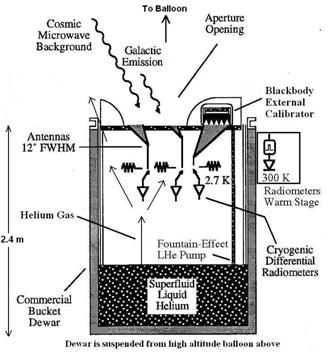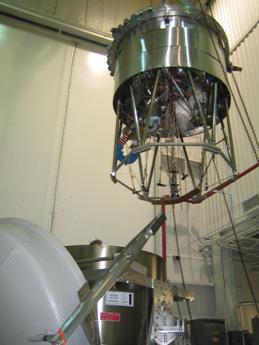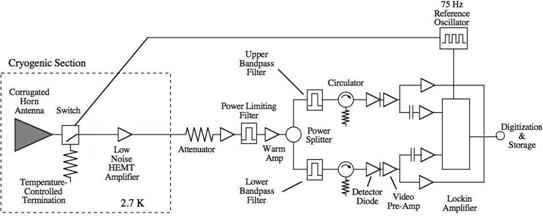- Home
- Classes
- Physics 150 – Nuclear Weapons – Physics, Policy, Proliferation – Fall 2025
- Physics 134 – Observational Astrophysics – Fall 2025
- Astro 1 Spring 2024
- INT 86TN Planetary Defense – Spring 2024
- Symmetry & Aesthetics in Contemporary Physics
- Physics 128 – Senior Lab – Winter 2026
- INT 184 – PL Interdisciplinary Honors Seminar – Weapons of Mass Destruction – Spring 2013
- Physics 150 – Modern Design and Fab – Fall 2019
- Physics 4 – Winter 2023
- Physics 141 – Optics – Spring 2019
- Physics 145L – Astrophysics Research
- Physics 199 – Independent Research
- Projects
- Interdisciplinary Center for Interstellar Exploration (iC)
- NASA Watts on the Moon
- Extrasolar Travelers
- CMB-S4 – Ground Based CMB Cosmology Program
- Wafer Scale Spacecraft
- PI-Multimodal Planetary Defense
- Lunar Rover Project
- DE-STAR
- Starlight
- GreenPol – CMB Cosmology
- PLANCK
- Starshot
- SETI
- Small Projects
- Previous Projects
- Facilities
- People
- Net
- Outreach
- Media Links
- NASA Space Grant Student Scholarships
- Bright Stars – VoH
- ARC – Undergraduate Aerospace Research Coop
- POINT – Undergraduate Physics Organization for Innovation and Technology
- All Sky Camera Project
- Education and Public Outreach
- Gaucho Rocket Project
- Undergrad Research Opportunities
- The Space Race
- Misc
- Papers
ARCADE
ARCADE – Absolute Radiometer for Cosmology, Astrophysics, and Diffuse Emission
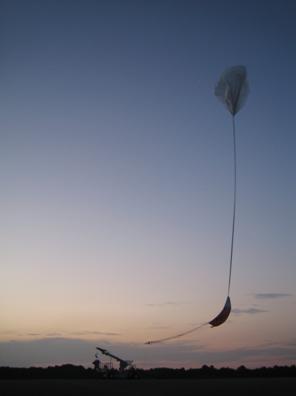
Photograph of 2005 ARCADE 2 launch, from NASA’s Columbia Scientific Balloon Facility in Palestine, TX. The balloon and flight train dominate the image, and the instrument hangs from the crane-like launch vehicle.
ARCADE 2 (Absolute Radiometer for Cosmology, Astrophysics, and Diffuse Emission) is a balloon-borne instrument which will measure the radiometric temperature of the sky at six frequencies, ranging from 3 to 90 GHz. The radiometric temperature at a given frequency is a measure of the intensity of electromagnetic radiation at that frequency, being the temperature that the radiating body would be if it were a perfect blackbody emitter and emitting with the observed intensity at the frequency in question.
The major science goals of the ARCADE project are: 1) to achieve a measurement of the extent to which the CMB deviates from a blackbody spectrum at long wavelengths, and 2) determine the absolute temperature of microwave emission from our own Galaxy
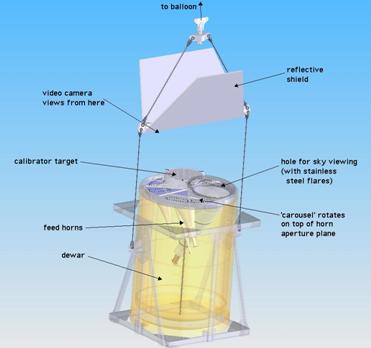
Schematic of ARCADE 2 instrument, showing the big dewar, the suspension structure above, the horns hanging inside to form the core.
Deviations in the CMB away from a blackbody can be caused by emission from ionized elections in the universe, and from non-equilibrium conditions in the early universe.
Most recent CMB intensity measurements, such as the famous WMAP, have been differencing measurements, which quantify very small differences from place to place on the sky. These measurements are generally statistics limited. In contrast, absolute measurements, such as with ARCADE, are limited by systematics and present an entirely different set of challenges.
In an absolute CMB temperature measurement, it is important to get above most of the atmosphere, to dramatically reduce the level of atmospheric microwave emission.
In order to achieve lower uncertainties than previous measurements, ARCADE 2 has a fully open-aperture cryogenic optics mounted at the top of a vary large (2.4 m tall, 1.5 m wide) open bucket liquid helium dewar. Radiation from the sky is compared by the radiometer to that from an external cryogenic full-aperture blackbody calibrator of known temperature.
ARCADE 2 builds on these instrument concepts which were tested with a previous smaller prototype, known as ARCADE 1, with observing channels at 10 and 30 GHz, that observed in 2003.
Radiation from the sky is received by corrugated horn antennas which hang from a flat, horizontal aperture plate at the top of the dewar. On top of the aperture, a carousel structure turns to expose the horns to either the sky, through a hole, or to the external calibrator. The calibrator consists of nearly 300 sharp cones of a microwave absorber cast over an aluminum core. It can be seen in the photograph below.
The horn antennas have 11.6 deg beams, so that the only flux that matters is that from the diffuse CMB and Galactic free-free and synchrotron signals. Point sources like stars are utterly irrelevant.
The major instrumental challenge is actually thermal: how to maintain all radiometrically active components (horns, external calibrator, radiometers) at near 4 Kelvin at the top of a very large dewar in the presence of varying gas atmospheres and without condensation of ambient gasses on the cold surfaces. Cooling power is supplied by constantly pumping liquid helium from the bottom of the dewar to needed places, and boioff helium gas is channeled to discourage condensation. Temperatures are often maintained with resistance heaters, and are read with ruthenium-oxide cryogenic resistance thermometers.
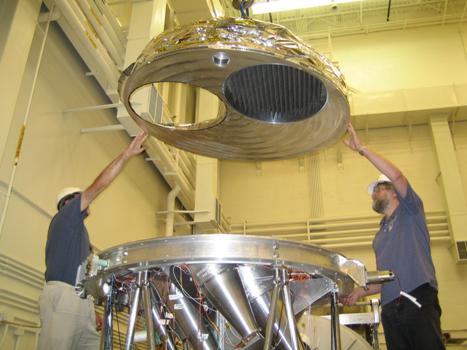
Photograph of the carousel, containing the hole for sky viewing and the external calibrator, being lowered on top of the horn antenna apertures.
ARCADE measures the incoming radiation in each frequency channel, whether from the sky or the external calibrator, with radiometers. A radiometer is a device which measures the power of incident EM radiation in a given frequency range from a given solid angle by converting it to a voltage. It is important that radiation with a radiometric temperature as cold as that of the CMB be amplified in a cold stage before any warm components are encountered, or else the emission from the warm components would dominate the actual signal. ARCADE uses Dicke radiometers, which switch at 75 Hz between the source and an internal load, and then demodulate the output. This subtracts out gain fluctuations in the cold amplifier.
For an observing flight, the ARCADE 2 instrument is launched on a high altitude balloon. It takes around three hours to reach the observing altitude of around 120,000 feet. At that
point, the lid is opened and sky data is taken for four or more hours, limited by the supply of liquid helium and the drift of the balloon out of range of telemetry. At the conclusion of observing, the lid is closed, and the instrument, separated from the balloon, drops to the ground on a parachute.
ARCADE 2 has observed twice, in July of 2005 and July of 2006.
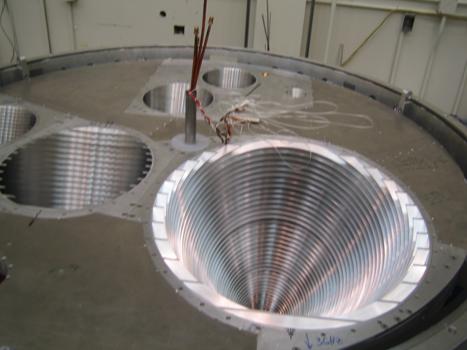
Photograph aperture plate from above, showing corrugated horn apertures. Visible in the center are small tubes and bundles of wires which extend upward to the carousel once it is placed on top. The tubes carry liquid helium for cooling, while the wires carry signals from thermometers. There are four wires for each for approximately 50 thermometers on the external calibrator and the rest of the carousel.
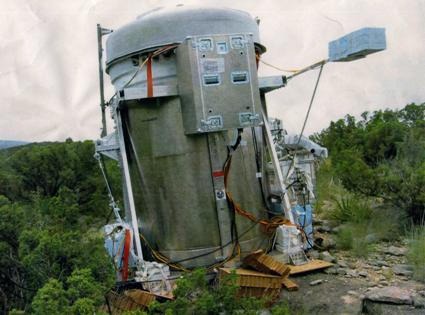
Photograph of the instrument upon landing, 2005. The electronics box and magnetometers which are mounted on the dewar are visible.

Schematic of ARCADE radiometers and photograph of the cold stage (cryogenic section) of the 8 GHz radiometer.
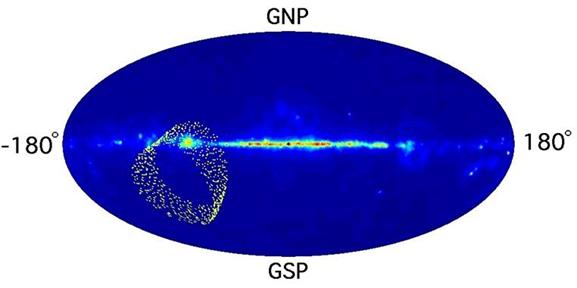
Portion of the sky viewed by ARCADE 2 in the 2005 flight, in Galactic coordinates, on top of a map of Galactic emission anisotropy at 22.3 GHz from WMAP. That viewed in the 2006 flight is similar. The center of the antenna beams traced out the circle shown as the dewar rotated below the balloon, with the circles drifting downward over time due to the combined effect of the balloon moving west and the Earth rotating. The map of Galactic emission shown is the combined 23 GHz Galactic emission map from the WMAP first year data release.
